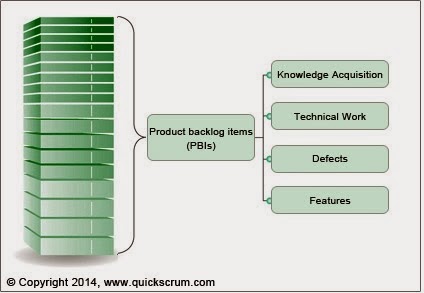A product owner has several
responsibilities, and is required to focus upon the two main aspects associated
with scrum – the end users, market conditions, and the stakeholders on one
hand, and the scrum team on the other. It is not an easy job to carry out.
Quite often, the product owner may be faced with a dilemma while carrying out
his or her responsibilities on behalf of the stakeholders, and convincing the
team members to perform, and act in their interests. It can be a challenging
position indeed.
The outward view: Users, customers,
and stakeholders
The first and the foremost priority for the product owner is to
understand the needs of end users and the customers. The basic purpose of
having a scrum project is to develop a product which is acceptable to them. The
consumers are important for the project since they determine whether the
product is going to succeed in the market, and if so, what the ideal product
ought to offer. The person may be required to conduct personal and group
interviews to understand their needs in depth, and avail a clear vision as to
what kind of product they really desire and expect. As is the case, many times
different users have their own ideas as to what the end product should
typically offer in terms of features and functionality. The product owner is
forced to review their expectations and ideas at a macro level and decide the
practical aspects concerning the product to be developed. If the users have
varying requirements or differing perspectives as to what the product should
include, it is eventually up to the product owner to decide which of the
aspects discussed are really important and feasible, and which can be
incorporated into the project.
The stakeholders are important since they invest into the project. The
product owner receives the actual product related requirements from the
stakeholders, who also have an idea regarding what the end users want. However,
their priorities and perspective is centered upon generating a profit out of
the project, and it is up to the product owner to deliver the project – nicely
wrapped up and ready for sale. The stakeholders also remunerate the efforts of
the entire scrum team including the product owner. It is therefore essential
that the product owner complies with their instructions and act in their direct
interests.
The product owner has to respond to the questions put forward by the
users, customers, and the stakeholders. He or she has to advise them, and
maintain a vision that can best convey what is important and profitable to
them.
The inward view: The
scrum team – scrum master and the development team
While the stakeholders and the end users are important, the
development team and the scrum master
too are important to the product owner since they are directly responsible for
developing the project. Scrum supports collaboration, and the entire team
collaborates with the product owner while scrum is implemented in the project.
Needless to say, without their help, it is not possible for the product owner
to deliver anything.
In most cases, the product owner acts as a facilitator and ensures the
team is properly working at all times. He or she has to remain close to the
actual development work, and be available whenever the team faces any problems
or issues with the acceptance criteria linked with the user stories, and resolve the issues when they occur. The product
owner has certain responsibilities towards them. Apart from being a product
owner, the person also acts as their mentor, guide, and a good friend when his
or her role so demands. Read more http://computersight.com/programming/dual-roles-of-a-product-owner-the-stakeholders-and-the-team-how-to-balance-them/

